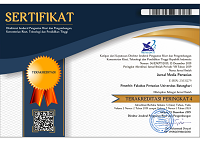Perbandingan Daya Hasil Varietas Bawang Merah di Kabupaten Sleman, Provinsi D.I. Yogyakarta
Abstract
Penggunaan varietas unggul merupakan salah satu strategi untuk meningkatkan produktivitas tanaman bawang merah. Varietas merupakan salah satu faktor kunci yang mempengaruhi pertumbuhan bawang merah. Suatu varietas dikatakan adaptif terhadap kondisi lingkungannya apabila pertumbuhan dan produktivitasnya tidak menunjukkan perbedaan yang nyata dibandingkan dengan kinerjanya di daerah penanaman asalnya. Penelitian ini bertujuan untuk mengevaluasi potensi hasil beberapa varietas bawang merah di Kabupaten Sleman. Penelitian dilaksanakan pada bulan April sampai dengan Juli 2024 di Kecamatan Kalasa, Kabupaten Sleman, Daerah Istimewa Yogyakarta. Metode yang digunakan adalah Rancangan Acak Kelompok Lengkap (RAL) dengan enam perlakuan varietas (V): V1 = Katumi, V2 = Kuning, V3 = Pikatan, V4 = Gempita Agrihorti, V5 = Kramat 1, dan enam kali ulangan, sehingga diperoleh total 30 satuan percobaan. Hasil penelitian menunjukkan bahwa varietas Gempita Agrihorti (V4) menunjukkan parameter pertumbuhan tinggi tanaman tertinggi pada umur 1-2 minggu setelah tanam (MST). Sementara itu, varietas Katumi (V1) secara konsisten menunjukkan kinerja terbaik pada beberapa parameter, meliputi bobot daun segar per rumpun, bobot biomassa segar per rumpun, bobot biomassa kering per rumpun, dan total padatan terlarut. Penelitian lebih lanjut diperlukan untuk mengeksplorasi penggunaan varietas adaptif lain dan jenis pupuk yang cocok untuk budidaya di dataran rendah, seperti di Kabupaten Sleman.
Keywords
Full Text:
PDFReferences
Alemu, D., Kitila, C., Garedew, W., Jule, L. T., Badassa, B., Nagaprasad, N., Seenivasan, V., Saka, A., & Ramaswamy, K. (2022). Growth, yield, and yield variables of onion (Allium Cepa L.) varieties as influenced by plantspacing at DambiDollo, Western Ethiopia. Scientific Reports, 12(1), 1–9. https://doi.org/10.1038/s41598-022-24993-x
Amir, A., Sharangi, A. B., Bal, S., Upadhyay, T. K., Khan, M. S., Ahmad, I., Alabdallah, N. M., Saeed, M., & Thapa, U. (2023). Genetic Variability and Diversity in Red Onion (Allium cepa L.) Genotypes: Elucidating Morpho-Horticultural and Quality Perspectives. Horticulturae, 9(9). https://doi.org/10.3390/horticulturae9091005
Azmi, Hidayat, I. M., & Wiguna, G. (2011). The Effect of Varieties and Size of Bulbs on Shallot Productivity. Jurnal Hortikultura, 21(3), 206–213.
Cahyaningrum, H., Saleh, Y., Hartanto, S., & Pertiwi, M. D. (2023). The effect of cultivation habits on the growth and yield of several shallot varieties. E3S Web of Conferences, 373, 03008. https://doi.org/10.1051/e3sconf/202337303008
Chattopadhyay, A., Baran Sharangi, A., Dutta, S., Das, S., & Denre, M. (2013). Genetic relatedness between quantitative and qualitative parameters in onion (Allium cepa L.). Vegetos, 26(1), 151–157. https://doi.org/10.5958/j.2229-4473.26.1.021
Faried, M., Syam’Un, E., Jalil, A., Cennawati, C., Wijaya, P. P., & Putri, R. W. (2024). Can pruning affect the growth of shallot (Allium ascalonicum L.) seedlings from seeds? Journal of Agriculture Faculty of Ege University, 61(2), 165–174. https://doi.org/10.20289/zfdergi.1358246
Hasanah, Y., Ginting, J., & Syahputra, A. S. (2022). Research article role of potassium source from eco enzyme on growth and production of shallot (Allium ascalonicum l.) varieties. Asian Journal of Plant Sciences, 21(1), 32–38. https://doi.org/10.3923/ajps.2022.32.38
Istina, I. N. (2016). Peningkatan Produksi Bawang Merah Melalui Teknik Pemupukan NPK. Jurnal Agro, 3(1), 36–42. https://doi.org/10.15575/810
Kania, S. R., & Maghfoer, M. D. (2018). Pengaruh Dosis Pupuk Kandang Kambing dan Waktu Aplikasi PGPR terhadap Pertumbuhan dan Hasil Bawang Merah (Allium ascalonicum L.). Jurnal Produksi Tanaman, 6(3), 407–414. http://download.garuda.kemdikbud.go.id/article.php?article=779703&val=6473&title=PENGARUH DOSIS PUPUK KANDANG KAMBING DAN WAKTU APLIKASI PGPR TERHADAP PERTUMBUHAN DAN HASIL BAWANG MERAH Allium ascaloniucum L
Khokhar, K. M. (2017). Environmental and genotypic effects on bulb development in onion–a review. Journal of Horticultural Science and Biotechnology, 92(5), 448–454. https://doi.org/10.1080/14620316.2017.1314199
Marpaung, A. E., & Rosliani, R. (2019). Adaptability of Growth and Yield on 5 varieties of Shallot (Allium ascalonicum L) in Wet Highland. Journal of Tropical Horticulture, 2(1), 1–5.
Rachmawati, D., Aisyawati, L., Latifah, E., Sandrakirana, R., & Baswarsiati. (2023). The Potential and Characteristics of Genetic Resources of 7 National Superior of Shallots Varieties in Indonesia. IOP Conference Series: Earth and Environmental Science, 1246(1). https://doi.org/10.1088/1755-1315/1246/1/012022
Rosero-Alpala, M. G., Fernández, J. L., & Velásquez-Arroyo, C. E. (2024). Cultivars of Ocañera onion (Allium cepa L.) under protected and open-field conditions. Agronomia Mesoamericana, 35. https://doi.org/10.15517/am.2024.55741
Saptana, Gunawan, E., Perwita, A. D., Sukmaya, S. G., Darwis, V., Ariningsih, E., & Ashari. (2021). The competitiveness analysis of shallot in Indonesia: A Policy Analysis Matrix. PLoS ONE, 16(9 September), 1–19. https://doi.org/10.1371/journal.pone.0256832
Sekara, A., Pokluda, R., Del Vacchio, L., Somma, S., & Caruso, G. (2017). Interactions among genotype, environment and agronomic practices on production and quality of storage onion (Allium cepa L.) - A review. Horticultural Science, 44(1), 21–42. https://doi.org/10.17221/92/2015-HORTSCI
Wassie, W. A., Assegahegn, G. F., Tsegaye, B. A., & Mekonnen, A. B. (2022). Evaluation of Intrarow Spacing on Growth and Yield Performance of Four Onion (Allium cepa L.) Varieties in Beyeda District, North Gondar, Ethiopia. Advances in Agriculture, 2022. https://doi.org/10.1155/2022/9408607
DOI: http://dx.doi.org/10.33087/jagro.v10i2.264
Refbacks
- There are currently no refbacks.

This work is licensed under a Creative Commons Attribution-ShareAlike 4.0 International License.
Jurnal Media Pertanian Published by Fakultas Pertanian Universitas Batanghari |



